History of the Dresden High Magnetic Field Laboratory
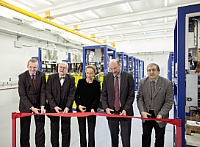 December 13, 2013: Saxony’s Minister of Science, Prof. Sabine von Schorlemer inaugurates new extension building
December 13, 2013: Saxony’s Minister of Science, Prof. Sabine von Schorlemer inaugurates new extension building
The extension building, a 20 million Euro investment largely funded by the Free State of Saxony, clearly broadens the capabilities of the HLD. The new building houses a second capacitor bank as well as six additional pulse cells, which has effectively doubled the lab’s size. more(1)
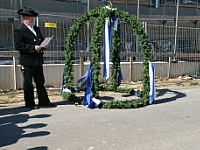 May 2, 2012: Topping Off Ceremony
May 2, 2012: Topping Off Ceremony
Ten months after the groundbreaking ceremony, there was once again reason to celebrate at the Dresden High Magnetic Field Laboratory. The structural work of the extension building is completed; the interior work and the installation of the equipment are about to begin. To symbolically commemorate the completion of the first construction phase, a crane raised a wreath to the top of the building. more(2)
 January 25, 2012: European Record with 94.2 Tesla
January 25, 2012: European Record with 94.2 Tesla
The Dresden High Magnetic Field Laboratory wants to break the world record for the highest magnetic fields. The scientists managed to improve their own European record from 91.4 to 94.2 Tesla. more(3)
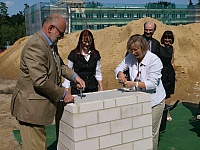 July 6, 2011: Laying of the foundation stone
July 6, 2011: Laying of the foundation stone
As a European user facility, the HLD is a strong and attractive partner for scientists from around the world. In order to better meet the growing demand for magnet time, the HLD will be expanded. The extension of the Dresden High Magnetic Field Laboratory is one of HZDR's projects for the future that will be realized in the coming years. more(4)
 June 22, 2011: World Record with 91.4 Tesla
June 22, 2011: World Record with 91.4 Tesla
To reach this record, the HLD team developed a coil weighing about 200 kilograms in which electric current create the giant magnetic field – for a period of a few milliseconds. The coil survived the experiment unscathed. more(5)
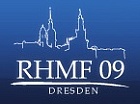 July 2009: HLD hosts International Conference on Research in High Magnetic Fields (RHMF 2009)
July 2009: HLD hosts International Conference on Research in High Magnetic Fields (RHMF 2009)
The conference is dedicated to all aspects related to recent advances in the research in high magnetic fields. Among the guests are leading scientists from all major high-field user laboratories in the world. more(6)
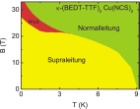 March 2008: HLD scientists proof new superconducting state
March 2008: HLD scientists proof new superconducting state
For the first time, a new state of superconductors - the Fulde-Ferrell-Larkin-Ovchinnikov phase - which was predicted already in 1964, was proved in experiments with organic superconductors.
 2007: HLD's start as a user facility
2007: HLD's start as a user facility
Scientists from all over the world may apply for magnet time. The HLD is part of the European network EuroMagNET. Applications for magnet time are evaluated within this cooperation. more(7)
 February 22, 2006: Saxon Prime Minister Prof. Georg Milbradt inaugurates the world's largest capacitor bank
February 22, 2006: Saxon Prime Minister Prof. Georg Milbradt inaugurates the world's largest capacitor bank
The most modern and most efficient way to safely store an energy up to 50 MJ and to discharge it to the magnetic-field coil is to use a pulse-discharge capacitor bank.With a single push of a button, a power is released to the magnet which would allow for braking an heavy engine (58 metric tons) from 150 km/h to zero in only ten milliseconds. more(8)
 December 1, 2004: Institute's foundation
December 1, 2004: Institute's foundation
Dresden High Magnetic Field Laboratory becomes Forschungszentrum Rossendorf's sixth institute. Prof. Joachim Wosnitza becomes director. more(9)
 May 28, 2003: Laying of the foundation stone for Dresden High Magnetic Field Laboratory
May 28, 2003: Laying of the foundation stone for Dresden High Magnetic Field Laboratory
The Federal Ministry of Education and Research (BMBF) and the Saxon Ministry of Science and Art follow the recommendation of the Wissenschaftsrat to promote the Dresden High Magnetic Field Laboratory. The investment costs amount to 24.5 million euros. more(10)
 2002: Wissenschaftsrat argues for the constitution of the Dresden High Magnetic Field Laboratory
2002: Wissenschaftsrat argues for the constitution of the Dresden High Magnetic Field Laboratory
After intensive review of the proposed project the German Council of Science and Humanities (Wissenschaftsrat) assigns the HLD to a group of research facilities that "promise new scientific discoveries". The Wissenschaftsrat considers the project worthy of unrestricted support. more(11)
URL of this article
https://www.hzdr.de/db/Cms?pOid=40802

